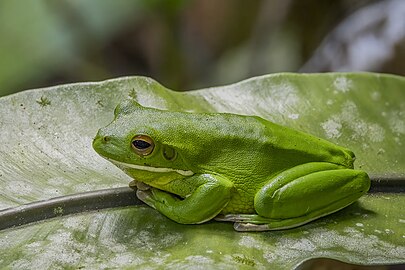White-lipped tree frog
| White-lipped tree frog | |
|---|---|

| |
| Scientific classification | |
| Domain: | Eukaryota |
| Kingdom: | Animalia |
| Phylum: | Chordata |
| Class: | Amphibia |
| Order: | Anura |
| Family: | Hylidae |
| Genus: | Nyctimystes |
| Species: | N. infrafrenatus
|
| Binomial name | |
| Nyctimystes infrafrenatus | |
| Synonyms | |
|
List
| |
The white-lipped tree frog (Nyctimystes infrafrenatus) is a species of frog in the subfamily Pelodryadinae. It is the world's largest tree frog (the Cuban tree frog reaches a similar maximum size) and is found in Australia. Other common names include the New Guinea treefrog, giant tree frog, and Australian giant treefrog.[4]
Description
The white-lipped tree frog reaches 11–14 cm (4.3–5.5 in) in length.
-
In Daintree rainforest, Queensland
-
A brown example
-
Being eaten by a green tree snake -Dendrelaphis punctulatus near Cooktown, Queensland
Ecology and behaviour
The white-lipped tree frog is found along the coastal areas of
It has a loud, barking call, but when distressed, it makes a cat-like "mew" sound or may discharge urine. Males call during spring and summer after rain from vegetation around the breeding site, normally a still body of water.
Its diet is mainly insects and other
This species of frog is known for being moved around in fruit produce from northern Australia and ending up becoming a lost frog in southern areas.
As a pet
It is kept as a pet; but in Australia, it may be kept in captivity only with an appropriate permit.
References
- doi:10.2305/IUCN.UK.2017-1.RLTS.T41095A114114070.en. Retrieved 19 November 2021.)
{{cite journal}}: CS1 maint: multiple names: authors list (link - ^ EOL.org
- ^ Barker, J., Grigg, G. C., and Tyler, M. J. (1995). A Field Guide to Australian Frogs. Surrey Beatty and Sons, New South Wales.
- ^ "Nyctimystes infrafrenatus (Günther, 1867) | Amphibian Species of the World". research.amnh.org. Retrieved 2019-10-02.
- ^ James Cook University, Australia: Litoria infrafrenata. Retrieved 19 June 2014[dead link]
- PMID 33551467.
- Menzies, J.I. (1976). Handbook of Common New Guinea Frogs. Wau Ecology Institute.
- Cronin, L., (2001). Australian Reptiles and Amphibians, Envirobook, ISBN 0-85881-186-3
- Cogger, H.G. (2000). Reptiles and amphibians of Australia. Reed Books: Sydney.
External links
- Queensland Department of Environment and Science: White-lipped tree frog—Conservation status and audio of frog call
- Frog Australia Network—frog call available here.
- [1]
- Article Road: List of All Frog Breeds: Things You Can Do to Ensure Your Frog Has a Long, Happy and Healthy Life: White Lipped Tree Frog
- Department of Environment, Climate Change and Water, New South Wales: Amphibian Keeper's Licence: Species Lists




